全球领导力-教学大纲英语
- 格式:doc
- 大小:47.50 KB
- 文档页数:6
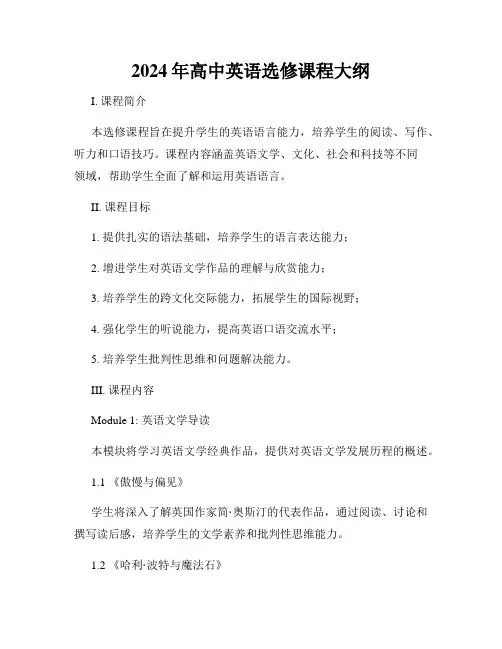
2024年高中英语选修课程大纲I. 课程简介本选修课程旨在提升学生的英语语言能力,培养学生的阅读、写作、听力和口语技巧。
课程内容涵盖英语文学、文化、社会和科技等不同领域,帮助学生全面了解和运用英语语言。
II. 课程目标1. 提供扎实的语法基础,培养学生的语言表达能力;2. 增进学生对英语文学作品的理解与欣赏能力;3. 培养学生的跨文化交际能力,拓展学生的国际视野;4. 强化学生的听说能力,提高英语口语交流水平;5. 培养学生批判性思维和问题解决能力。
III. 课程内容Module 1: 英语文学导读本模块将学习英语文学经典作品,提供对英语文学发展历程的概述。
1.1 《傲慢与偏见》学生将深入了解英国作家简·奥斯汀的代表作品,通过阅读、讨论和撰写读后感,培养学生的文学素养和批判性思维能力。
1.2 《哈利·波特与魔法石》学生将通过阅读J.K.罗琳的作品,探讨她所塑造的魔幻世界,同时讨论人类与社会的主题如友谊、勇气和正义。
Module 2: 跨文化交际本模块旨在提高学生的跨文化交际能力,培养学生在国际交流中的自信与流利程度。
2.1 文化差异与交际技巧学生将深入了解不同文化背景下的价值观和行为规范,学习有效的跨文化交际技巧,并通过角色扮演和讨论活动加以实践。
2.2 国际新闻阅读与讨论学生将阅读和分析来自全球范围内的新闻报道,讨论国际社会的热点问题,并发表个人观点,提升学生的思辨能力和口头表达能力。
Module 3: 英语写作与辩论本模块旨在培养学生的写作能力和辩论技巧,提高学生的表达和论证能力。
3.1 学术论文写作学生将学习学术论文写作的基本要素,包括选题、撰写提纲、引用资料和提出论点等,通过实践提升学生的学术写作水平。
3.2 辩论技巧与实践学生将学习辩论的基本技巧,分析辩题,准备辩论论据,并参与团队辩论,培养学生的逻辑思维和辩证分析能力。
Module 4: 科技与社会本模块将探讨科技对社会发展的影响,提醒学生对科技应用的准确理解和合理运用。


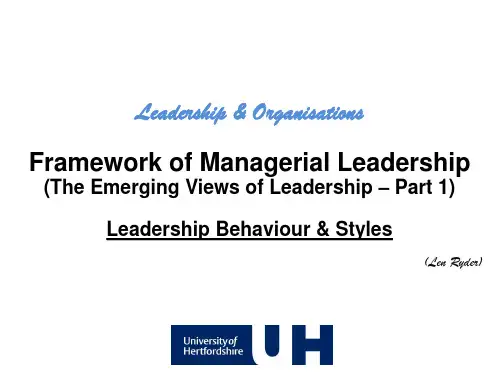
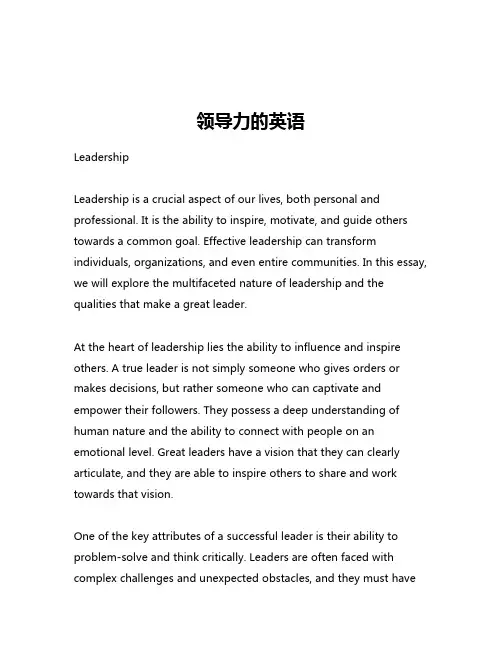
领导力的英语LeadershipLeadership is a crucial aspect of our lives, both personal and professional. It is the ability to inspire, motivate, and guide others towards a common goal. Effective leadership can transform individuals, organizations, and even entire communities. In this essay, we will explore the multifaceted nature of leadership and the qualities that make a great leader.At the heart of leadership lies the ability to influence and inspire others. A true leader is not simply someone who gives orders or makes decisions, but rather someone who can captivate and empower their followers. They possess a deep understanding of human nature and the ability to connect with people on an emotional level. Great leaders have a vision that they can clearly articulate, and they are able to inspire others to share and work towards that vision.One of the key attributes of a successful leader is their ability to problem-solve and think critically. Leaders are often faced with complex challenges and unexpected obstacles, and they must havethe cognitive flexibility to adapt and find innovative solutions. They must be able to analyze situations from multiple perspectives, weighing the pros and cons of various courses of action. This ability to think critically and make well-informed decisions is essential for effective leadership.Another crucial aspect of leadership is the ability to foster a positive and collaborative work environment. Great leaders understand the importance of building strong, cohesive teams and empowering their followers to contribute their unique skills and perspectives. They create a culture of trust, open communication, and mutual respect, which in turn leads to increased productivity, creativity, and job satisfaction among team members.Effective leaders also possess strong communication skills, both verbal and nonverbal. They are able to articulate their ideas clearly and concisely, and they are skilled listeners who can truly hear and understand the concerns and perspectives of their followers. Additionally, they are adept at using body language and facial expressions to convey confidence, empathy, and authority.Integrity is another essential quality of a great leader. Leaders must be authentic, transparent, and accountable for their actions. They must have a strong moral compass and consistently demonstrate their commitment to ethical behavior. When followers trust that theirleader is acting with integrity, they are more likely to be loyal, committed, and willing to follow that leader's lead.In addition to the qualities mentioned above, successful leaders also possess a certain degree of emotional intelligence. They are able to recognize and manage their own emotions, as well as the emotions of their followers. They can empathize with others, read social cues, and adjust their communication and leadership style accordingly. This emotional intelligence allows them to create a positive and supportive environment, which in turn fosters loyalty, motivation, and high performance among their team members.Finally, great leaders are continuous learners who are always striving to improve and expand their knowledge and skills. They are open to feedback, willing to admit their mistakes, and eager to seek out new perspectives and experiences. This commitment to personal and professional growth not only benefits the leader themselves but also inspires and encourages their followers to do the same.In conclusion, leadership is a multifaceted and complex concept that encompasses a wide range of qualities and skills. From inspiring and motivating others to problem-solving and fostering a positive work environment, effective leaders possess a unique blend of cognitive, emotional, and interpersonal abilities. By cultivating these essential leadership qualities, individuals can not only improve their ownperformance and success but also have a transformative impact on the lives of those they lead.。
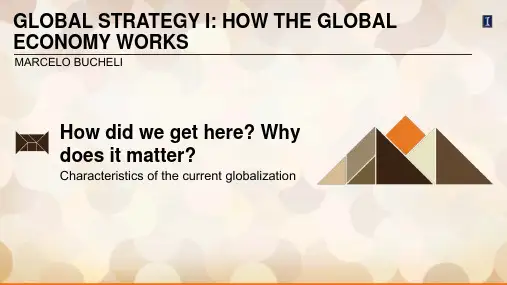
GLOBAL STRATEGY I: HOW THE GLOBAL ECONOMY WORKSMARCELO BUCHELIHow did we get here? Whydoes it matter?Characteristics of the current globalizationCHARACTERISTICS OF THE GLOBAL ECONOMY What characteristics does this global economy have?First: the Internet technology has permitted a great flow of information that allows firms located in far away places to coordinate with each otherSecond, we have players from many countries of the world. Multinationals from Russia, Brazil, China or India compete with those from Western Europe, Japan, or the United StatesThis responds to the fact that non-Western countries have increased their participation in the global economyTHE GOVERNMENTS ROLEThird, governments play an important role as investors or promoters of foreign investment© 2012Pavel KazachkovGENERAL CHARACTERISTICS OF NOWADAYS GLOBALIZATIONThe participation of companies of non-Western countries The increasing role of governments in the economyThe role of the Internet at permitting global coordination The existence of global value chainsREFERENCESBucheli, M., & Darby, J. (2017). Increasing participation of emerging economies in the total. University of Illinois.Kazachkov, P. (Photographer). (2012, December 17). Kremlin Moscow [digital image]. CC BY 2.0. Retrieved from https://goo.gl/YfMHvVGLOBAL STRATEGY I: HOW THE GLOBAL ECONOMY WORKSMARCELO BUCHELIHow did we get here? Whydoes it matter?China and India: re-emerging economiesRE-EMERGING ECONOMIES We talk about China and India asemerging economies. But probably themost accurate term would be “re-emerging economies”INDIA IN THE LATE 18TH CENTURYBut they’ve been important for along timeTake India: in the late 18th centuryIndia’s manufacturing output waslarger than Great BritainCHINA IN THE YEAR1800 Or China, that in the year of 1800 it represented almost 50% of theworld’s economyPARTICIPATION IN THE WORLD ECONOMY It is true that their participation in theeconomy has increased© 2010Miacek© 2013Srikar KashyapIMPERIALISMThe global importance of both countries decreased as a result of isolationist policies and Western imperialismIndia: Invaded by the British empire. Its manufacturing output limited by theBritsChina: Its growth affected by… (reasons in attached power point)IMPERIALISMIndia remained a colony until 1948. Afterwards, it opted for a protectionist economic system it dismantled in the 1990sChina: became insignificant in the world economy after Opium Wars.Invaded by Western powers. Destructive World War II. Revolution did not translate into economic growthCHINA AND INDIA TODAYNowadays, both China and India areShanghai,Chinamajor players in the world economyThey face challenges such asdemographic pressures, but they’reback. They re-emergedMumbai,India© 2014Uri ToursREFERENCESKashyap, S. (Photographer). (2013, January 16). US,China and India projected GDP growth 2009-2050 Pwc[digital image]. CC BY-SA 3.0. Retrieved from https://goo.gl/tafxPaMalhotra, V. (Photographer). (2015, May 28). Mumbai Springs [digital image]. CC BY-SA 2.0. Retrieved from https://goo.gl/5J1NUC Miacek. (2010, August 15). China india gdp[digital image]. CC BY-SA 3.0. Retrieved from https://goo.gl/Bj5jmKUri Tours. (2014, June 5). Shanghai photos [digital image]. CC BY-SA 2.0. Retrieved from https://goo.gl/dd9D0eGLOBAL STRATEGY I: HOW THE GLOBAL ECONOMY WORKSMARCELO BUCHELIHow did we get here? Whydoes it matter?The Three Stages of GlobalizationTHE CURRENT GLOBALIZATION The current globalization is just butthe latest globalization process. In themodern era this process waspreceded by two othersPOLITICS AND GLOBALIZATION Even though technology alwaysimproved, the world did not becomemore globalThe reason is mainly politics. Whenglobalization proved to be politicallyunfeasible, it was rejectedWORLD WAR IFirst shock, World War I© 2012DrRandomFactor© 2010VarminTHE BOLSHEVIK REVOLUTION The Bolshevik Revolution took awayfrom the world markets a big portion ofthe humanityTHE GREAT DEPRESSION Then, the Great DepressionUnemployment led to protectionism in Western countriesTHE CHINESE REVOLUTIONLater, the Chinese revolution put ¼ of the humanity under CommunismRUSSIA AND CHINA’S NEW ECONOMIC MODEL The world changed when the Russians and the Chinese opted for a new market-oriented economic model© 1989Lear 21AGGRESSIVE MARKET REFORMSBy that time the non-communist world also embarked in aggressive market reforms, as were the cases of Ronald Reagan in the US, Margaret Thatcher in the UK, or Augusto Pinochet in Chile© Biblioteca del Congreso NacionalA NEW PERIOD OF ECONOMIC NATIONALISM After a period in the 1990s of a global acceptance of the benefits of reducing tariffs and opening borders, the post-2008 world showed a different scenario The crisis started a new period of economic nationalism© 2010Janah Hattingh© 2010Janah HattinghTHE CURRENT GLOBALIZATION The current globalization is just butthe latest globalization process. In themodern era this process waspreceded by two othersREFERENCESBucheli, M., & Darby, J. (2017). Three stages of globalization. University of Illinois.Del Congreso Nacional, B. (Photographer). (n.d.). William Thayer Augusto Pinochet Ugarte[digital image]. CC BY 3.0. Retrieved from https://goo.gl/4faEa6DrRandomFactor. (2012, November 16). Flag map of Colonial Africa (1945) [digital image]. CC BY-SA 3.0. Retrieved fromhttps://goo.gl/PEOo88Hattingh, J. (Photographer). (2010, July 18). Fan Walk For Peace And Unity (4813216834) (2) [digital image]. CC BY 2.0. Retrieved from https://goo.gl/JunhzqHattingh, J. (Photographer). (2010, July 18). Fan Walk For Peace And Unity (4813215838) [digital image]. CC BY 2.0. Retrieved from https://goo.gl/UhVTnyLear 21. (1989). The Fall of the Berlin Wall [digital image]. CC BY-SA 3.0. Retrieved from https://goo.gl/pk31pQVarmin. (2010, March 21). Map Europe regimes 1914 [digital image]. CC BY-SA 3.0. Retrieved from https://goo.gl/tckwSD。
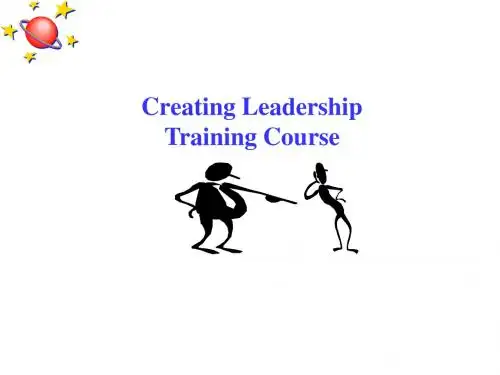
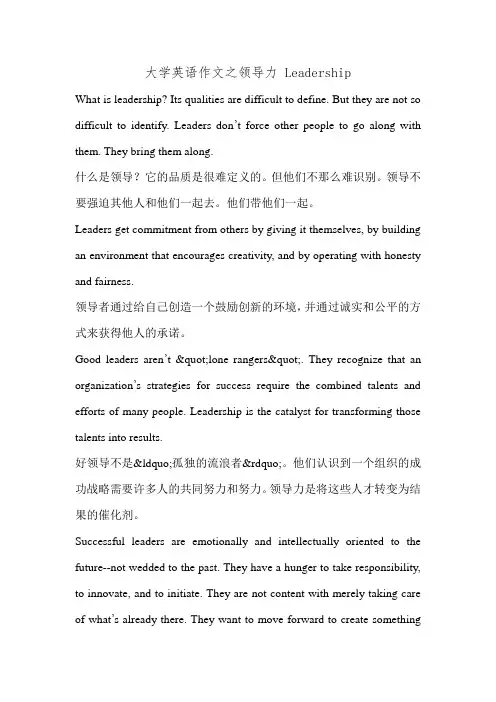
大学英语作文之领导力 LeadershipWhat is leadership? Its qualities are difficult to define. But they are not so difficult to identify. Leaders don’t force other people to go along with them. They bring them along.什么是领导?它的品质是很难定义的。
但他们不那么难识别。
领导不要强迫其他人和他们一起去。
他们带他们一起。
Leaders get commitment from others by giving it themselves, by building an environment that encourages creativity, and by operating with honesty and fairness.领导者通过给自己创造一个鼓励创新的环境,并通过诚实和公平的方式来获得他人的承诺。
Good leaders aren’t "lone rangers". They recognize that an organization’s strategies for success require the combined talents and efforts of many people. Leadership is the catalyst for transforming those talents into results.好领导不是“孤独的流浪者”。
他们认识到一个组织的成功战略需要许多人的共同努力和努力。
领导力是将这些人才转变为结果的催化剂。
Successful leaders are emotionally and intellectually oriented to the future--not wedded to the past. They have a hunger to take responsibility, to innovate, and to initiate. They are not content with merely taking care of what’s already there. They want to move forward to create somethingnew.成功的领导者在感情上和理智上都着眼于未来——不是过去。
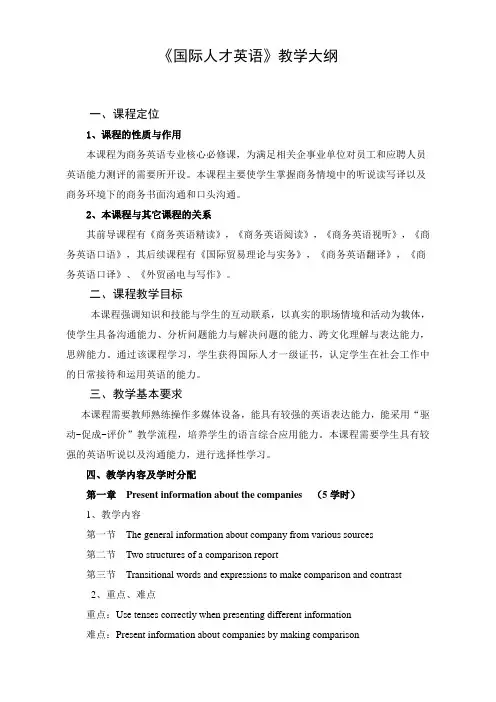
《国际人才英语》教学大纲一、课程定位1、课程的性质与作用本课程为商务英语专业核心必修课,为满足相关企事业单位对员工和应聘人员英语能力测评的需要所开设。
本课程主要使学生掌握商务情境中的听说读写译以及商务环境下的商务书面沟通和口头沟通。
2、本课程与其它课程的关系其前导课程有《商务英语精读》,《商务英语阅读》,《商务英语视听》,《商务英语口语》,其后续课程有《国际贸易理论与实务》,《商务英语翻译》,《商务英语口译》、《外贸函电与写作》。
二、课程教学目标本课程强调知识和技能与学生的互动联系,以真实的职场情境和活动为载体,使学生具备沟通能力、分析问题能力与解决问题的能力、跨文化理解与表达能力,思辨能力。
通过该课程学习,学生获得国际人才一级证书,认定学生在社会工作中的日常接待和运用英语的能力。
三、教学基本要求本课程需要教师熟练操作多媒体设备,能具有较强的英语表达能力,能采用“驱动-促成-评价”教学流程,培养学生的语言综合应用能力。
本课程需要学生具有较强的英语听说以及沟通能力,进行选择性学习。
四、教学内容及学时分配第一章Present information about the companies (5学时)1、教学内容第一节The general information about company from various sources第二节Two structures of a comparison report第三节Transitional words and expressions to make comparison and contrast2、重点、难点重点:Use tenses correctly when presenting different information难点:Present information about companies by making comparison第二章Make arrangements for the field trip (4学时)1、教学内容第一节Specific information like numbers, dates, places and events 第二节The structure of an agenda第三节Write concise and specific information2、重点、难点重点:Planning agenda items难点:Create the field trip agenda第三章Categorize the audience’s feedback (5学时)1、教学内容第一节Identify different people’s attitudes from various sources 第二节The structure of a T-chart第三节Express likes and dislikes2、重点、难点重点:Categorize information in the same aspect难点:Make a T-chart to categorize the audience’s feedback第四章Summarize the feedback (4学时)1、教学内容第一节Get specific information from various sources第二节The structure of a feedback summary第三节Reporting verbs in summary writing2、重点、难点重点:Use data to make a summary more convincing难点:Summarize the feedback第五章Propose a new guest (4学时)1、教学内容第一节Get information about a person from various sources第二节The structure of a proposal email第三节Writing supporting details: figures and examples2、重点、难点重点:Writing an effective subject line难点:Writing a proposal email第六章Introduce the show to the new guest (5学时)1、教学内容第一节Get information about the show from various sources第二节The structure of a program introduction第三节Persuasive techniques in a program introduction2、重点、难点重点:Appropriate communication approach难点:Draft the program introduction第七章Express opinions in the meeting (5学时)1、教学内容第一节Get specific information and evaluate information from various sources 第二节The structure of expressing opinions第三节Express opinions and give evidence2、重点、难点重点:Avoid vague language in expressing opinions难点:Express clear and well-supported opinions in the meeting第八章Give feedback on the new program proposal (4学时)1、教学内容第一节Identify people’s attitudes from various sources第二节The structure of a proposal acceptance email第三节Express acceptance2、重点、难点重点:Show appreciation in the correct way难点:Writing a proposal acceptance email第九章Speaking(8学时)1、教学内容第一节Business establishment第二节Telephone voice message第三节Product presentation2、重点、难点重点:Business contact in a specific business environment难点:Oral message delivery and enquiry discussion第十章Writing (8学时)1、教学内容第一节Letter of complaints第二节Letter of apology第三节Letter of invitation2、重点、难点重点:Email structure难点:Key sentences and words application五、课程考核本课程的期末考查为闭卷形式,主要以书面表达为主,教师以各学期的课程进度来设置期末考查范围。
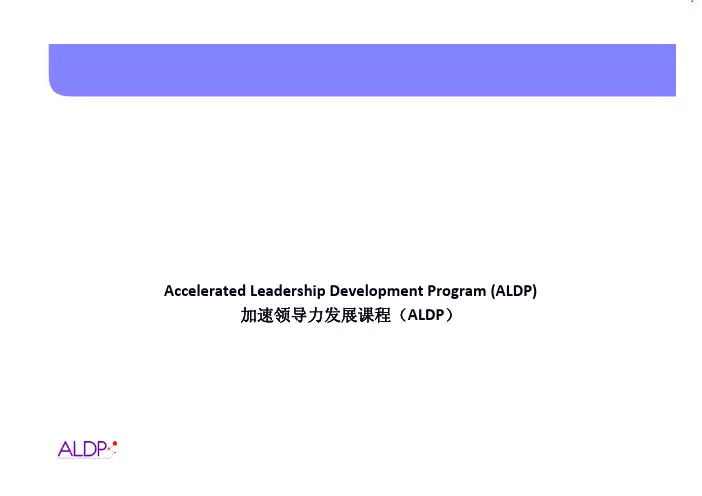
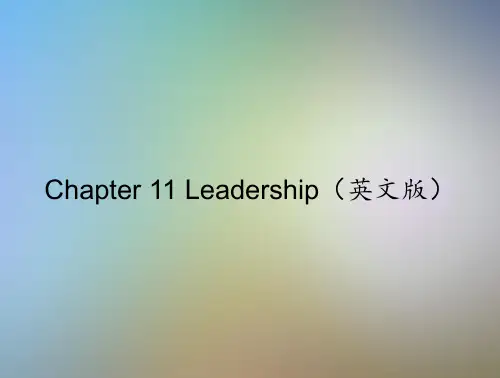
《全球市场营销管理》课程教学大纲一、课程基本信息课程代码:16108303课程名称:全球市场营销管理英文名称:Global Market Management课程类别:专业课学时:48学分:3适用对象:经济、管理类专业考核方式:考试先修课程:市场营销二、课程简介在国际化迅速发展的今天,具有全球性的思维并对国际市场与国内市场差异有所认识是必不可少的,全球营销管理已经成为近20年来营销和国际管理领域中发展最快的部分之一。
课程会分别从全球营销导论、全球营销环境、目标市场机会的分析和评价、全球营销战略、全球营销方案的设计与管理等方面对当前全球营销的理论和实践进行描述和总结。
本课程将以全英文授课。
同时,通过本门课的学习,希望培养学生在各种专业学习和科学研究活动中运用英语的能力。
我们可以使用英语进行学术研究,以提高交流能力,信息获取,整合和应用能力。
With the rapid development of internationalization today, it is indispensable to have aglobal mindset and understand the differences between the international market and the domestic market. Global marketing management has become one of the fastest-growing parts in marketing and international management in the past 20 years. The course will summarize the current global marketing theory and practice from the global marketing introduction, global marketing environment, target market opportunity analysis and evaluation, global marketing strategy, and global marketing plan design and management.This course will be taught in English. At the same time, it is necessary to cultivate students' ability of applying English language in various professional learning and scientific research activities. We can use English to carry on academic research communication ability, information acquisition, integration and application ability.三、课程性质与教学目的本课程是一门全英课程,是专门针对金融学(“2+2”实验班)本科学生开设的一门专业必修课。
《大学英语》课程教学大纲第一部分说明一、课程的性质和作用大学英语教学是高等教育的一个有机组成部分,大学英语课程是大学生的一门必修基础课。
大学英语教学是以英语语言知识与应用技能、学习策略和跨文化交际为主要内容,以外语教学理论为指导并集多种教学模式和教学手段为一体的教学体系。
大学英语教学的作用是:培养学生具有较强的阅读能力和一定的听、说、写、译能力,使他们能用英语交流信息;帮助学生打下扎实的语言基础,掌握良好的语言学习方法,提高文化素质,以适应社会发展和经济建设的需要。
二、课程的任务与基本要求大学英语教学是实施全面素质教育的主要途径。
语言基本功的训练是大学英语教学的首要任务,并且贯穿于教学的全过程,在注重学生听、说、读、写、译各项技能全面发展的同时,突出说、写、译等语言交际能力的培养。
大学英语课程教学既提高学生的业务素质,又培养其思想道德素质、文化素质和心理素质,并重视学生思维能力和创新能力的养成。
课程教学的目的:大学英语教学指基础阶段的英语学习,即一至二年级四个学期。
其目的是为学生打好扎实的语言基础的同时,进一步培养和提高学生的阅读能力和一定的听、说、读、写、译能力。
通过提问和讨论,培养学生分析、推理、归纳、综合等思考能力和表述、研讨、争辩、应答等语言运用能力。
挖掘课本中富有“内涵意义”的语言内容,注重人对社会现实的思考。
具体要求如下:经过基础阶段的英语学习,使学生达到高等学校大学英语四级(College English Test 4, 简称CET-4)的水平。
1. 基本要求1)词汇领会式掌握4,200单词(其中复用式掌握的单词为2,500),以及由这些词构成的常用词组(中学所掌握的单词和词组包括在内),并具有根据构词法知识识别生词的能力。
2)阅读能力能顺利阅读语言难度中等的一般性题材的文章,掌握中心大意以及说明中心大意的事实和细节,并能就文章的内容进行分析、推理、判断和综合概括,领会作者的观点和态度,阅读速度达到每分钟60词。
leadership(领导力)在丢丢的博客上,我看到一段她留美日记,是讲leadership(领导力)课程的,没想到美国的学生在高中就已经开始领导力训练了,而我却一直认为领导力培训是要等到进了企业才进行的。
我想起我第一次做班主任的时候,那真的是一切从零开始啊,尽管用心去做,效果也只是普普通通。
原文:留美日记(五十)——我的“领导力”课程今天记述一下我的leadership(领导力)课程。
这是我在中国唯一没有接触过的课堂形式,很新奇,很有挑战性,很让人深思。
这门课让我意识到美国教学是很高科技的。
经常是老师学生人手拎一台笔记本电脑,在教室的方桌边坐成一圈。
老师说:好,现在在你的电脑里输入某某网址,读一篇文章。
限时10分钟,然后每人给我做一个3分钟的presentation(演讲),我会观察你的语言内容,动作,眼神和脚步,给你们打分。
一般拿到的文章都很长,都差不多3-4页。
我们必须在10分钟内读完,随手打开word文档写点笔记和要点,然后就上去演讲了。
演讲禁止说任何语气词:Ah, eh, like……,you know……, so……都不可以,否则扣分;眼睛必须看着每一个人,不能看地板天花板什么的,否则扣分;演讲全部脱稿,要内容连贯中心突出,前言不搭后语扣分……总之每一次上课对我来说都是挑战:首先,我是课上来美国时间最短的学生(其他两个韩国人来美国有3,4年了),刚开始在10分钟之内根本读不完文章,加上查字典的时间,一半都读不到。
其次,英语是我的外语,表达得肯定不够清楚,而我既没有准备的时间,演讲时又容不得思考。
最重要的,演讲的时候会很紧张!第三,这门课的论文和课题是最多的,不停地写论文,就没有完的时候。
让我压力很大……最后是我的打字速度问题。
这个关系到演讲笔记和论文两方面,打字快可以省不少时间。
但是我中文打字原本就慢,别提英文了。
经过3个月的磨练,取得了不小的成果:首先我找老师谈话。
虽然我阅读的速度已经提高很多了,但是如果文章长过3页,就让PK (这门课的老师,他是校长的弟弟,姓Kennedy,名字开头字母是p。
《全球领导力(英语)》教学大纲
课程编号:050982B
课程类型:□通识教育必修课□通识教育选修课
□专业必修课□专业选修课
□学科基础课
总学时:32 讲课学时:32 实验(上机)学时:
学分:2
适用对象:人力资源管理(国人、人力、人实三个方向)
先修课程:管理学,人力资源管理
一、教学目标
本课程具有很强的理论性与实践性,可以加强学生对所学管理类课程的认识和理解,更需要学生从另一种角度来看企业的管理问题。
学完本课程,学生可以了解不断变化的国际大环境,了解跨国经营的机会与风险,熟悉领导的概念与相关理论,并初步掌握基本的领导技巧。
教学目标1:使学生了解国际化管理的现状与挑战。
教学目标2:使学生掌握全球领导力的主要理论、模型及发展动态。
教学目标3:通过案例讨论与情境模拟,使学生初步掌握一定的领导技巧。
二、教学基本要求
(一)教学内容
教学的主要内容包括:变化的环境与跨国经营,领导的定义及相关概念,领
导者、追随者和情境三者之间的互动,领导者的特质与价值观,领导的权变理论,领导者的沟通技能,领导与变革。
(二)教学方法和手段
课堂讲授,案例讨论,情景模拟,课外实践。
(三)学习要求
1.知识储备:管理学/组织行为学,人力资源管理学。
2.参与教学:积极开展课外阅读,认真搜集与整理资料,认真完成作业,积极参与讨论与课外实践,撰写较高质量的期末论文。
三、各教学环节学时分配
教学各环节学时分配表
四、教学内容(1500字以内)
第一章领导学概论
第一节领导的基础概念群组。
第二节:领导分析的互动框架。
第三节: 经济全球化背景下的领导。
本章重点和难点:领导分析的互动框架及其应用。
本章教学组织和设计:课堂教学3学时,案例讨论1学时。
在介绍基本概念之后,引导学生通过讨论加深对领导的认识和理解。
本章的学习标准:了解经济全球化的大趋势,跨国经营的机会与风险;理解领导者、追随者与情景之间的互动关系;掌握领导的概念,领导与管理的区别,领导分析的框架。
第二章领导力培养
第一节领导者权力的来源与动机。
第二节领导领导力开发。
第三节通用电气公司领导力培养。
本章重点和难点:使学生真正理解领导领导与职位的不同。
本章教学组织和设计:课堂教学3学时,案例讨论1学时。
通过对世界著名公司GE的案例研讨,引导学生熟悉相关概念,加深对关键知识点的认识和理解。
本章的学习标准:了解领导者权力的来源;理解领导的动机理论;掌握领导力开发的方法与技巧。
第三章领导的特质
第一节心理学基础。
第二节智商与领导。
第三节情商与领导。
本章重点和难点:心理学关于人格的基础知识,人格特质与领导,智力与领导,情商与领导。
本章教学组织和设计:本章更多的是关于心理学研究成果的应用,因此以教学为主,适当引入著名企业领导人个案。
本章的学习标准:了解一些基础的心理学知识;理解人格特质与领导、智力
与领导的相互关系;掌握情商与领导的相关知识与技巧。
第四章领导行为与风格
第一节领导行为理论
第二节领导力胜任模型
第三节典型国家领导风格分析
本章重点和难点:为什么要研究领导行为,领导胜任力模型,领导方格论,中、日、美三国领导风格分析,领导开发管道。
本章教学组织和设计:用3学时介绍相关理论,用1学时引导学生对中、日、美三国企业领导进行对比分析,从而加深对本章内容的理解和记忆。
本章的学习标准:了解研究领导行为的必要性,理解中、日、美三国领导的典型风格,掌握领导胜任力模型和领导开发管道。
第五章领导的情境理论
第一节领导情境
第二节领导力扩展模型
第三节工业组织中的领导力
本章重点和难点:情境的概念和特征,领导者、追随者和情境的扩展模型,相合模型,工作与组织,情境工程。
本章教学组织和设计:用3学时来教授基本概念和重要知识点,用1学时来引导学生进行案例讨论,从而加深对相关知识和理论的认识与理解。
本章的学习标准:了解情境的概念和特征,情境工程;理解情境理论的深刻内涵;掌握领导者、追随者和情境的扩展模型。
第六章领导的权变模型
第一节领导力情境模型的发展
第二节权变理论
第三节其他典型领导力理论
本章重点和难点:情境领导模型,追随者的准备度,关于情境领导模型的总结性思考,权变模型,路径-目标理论。
本章教学组织和设计:用4学时来进行理论讲授,用2学时来讨论两个经典案例,以加深认识和理解。
本章的学习标准:了解情境领导模型,追随者的准备;理解权变模型的重要内涵;掌握关于情境领导模型的总结性思考,权变模型,与路径-目标理论。
第七章跨文化团队与领导
第一节团队理论基础
第二节团队适应与团队组建
第三节跨文化团队建设
本章重点和难点:团队的概念,团队的类型,团队的理想状态,导致团队失败的因素,跨文化团队的优点与缺点,跨文化团队的类型,多文化团队建设本章教学组织和设计:本章内容丰富,主要以课堂讲授。
本章的学习标准:了解关于团队建设的常见假设及其检验结果;理解团队建设的基础知识;掌握跨文化团队的建设技巧。
第八章领导与变革
第一节组织变革基础
第二节领导类型研究
第三节组织变革的艺术
本章重点和难点:领导与管理的再次探讨,组织变革的理性方法,魅力型领导与变革型领导,巴斯的变革型领导和交易型领导。
本章教学组织和设计:用3学时进行理论讲授,用1学时进行案例研讨。
本章的学习标准:了解组织的寿命周期理论,变革的必要性;理解变革的重
点与难点:掌握领导的类型,组织变革的理性方法。
五、考核方式
1、期末考试为闭卷考试。
卷面分为100分。
2、总成绩构成:平时成绩30%,期末成绩70%。
六、主要参考书目
[1]理查德·哈格斯等. 领导学——在经验积累中提升领导力(第五版). 北京:清华大学出版社, 2007
[2]拉里·博西迪等. 转型——用对策略,做对事. 北京:中信出版社, 2005
[3]李翔. 商业领袖访谈录. 青岛:青岛出版社, 2009
[4]约翰·科特等. 权力与影响. 北京:华夏出版社, 2003
[5]杨壮. 做一个有影响力的人:北大领导力十堂课. 北京:机械工业出版社,2008
[6]凯利·普度等. 西点的10堂领导课. 北京:中信出版社, 2007
[7]詹姆斯·麦格雷戈·伯恩斯.领导学.中国人民大学出版社,2013
执笔人:周施恩教研室主任:系教学主任审核签名:。